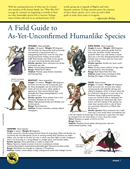With the amazing discovery of what may be a brand new member of the human family tree  (see “Who Was Flo?” on page 8), scientists are beginning to wonder if there are other humanlike species left to uncover. Perhaps there’s even the remote possibility that some of them still exist in an uncharted part of the world, helping give rise to legends of Bigfoot and other fantastic creatures. To help scientists prove the existence of such rare species, we’ve come up with a field guide to make them easier to recognize.
(see “Who Was Flo?” on page 8), scientists are beginning to wonder if there are other humanlike species left to uncover. Perhaps there’s even the remote possibility that some of them still exist in an uncharted part of the world, helping give rise to legends of Bigfoot and other fantastic creatures. To help scientists prove the existence of such rare species, we’ve come up with a field guide to make them easier to recognize.
WIZARD Homo gandalfus
Height 1.8 meters Weight 90 kilograms
Tall and lanky, the long pointed skull (commonly concealed by a long pointed hat) is a distinguishing field mark. Look for long robes and gnarled hands holding carved wooden staffs. Both females and males of the species may sport luxuriously flowing white beards.
Similar species: Homo sarumanus has darker and bushier eye tufts.
Voice: Commanding, Shakespearean.
Range: Middle-Earth, Valinor.
Habitat: Marshes, caves, forests, mountains, the Prancing Pony.
KING KONG Homo kongiensis
Height 15 meters Weight 1000 kilograms
Our only known ginormous gorilla. Dark fur, brown eyes. Excellent climber, extremely powerful. Often seen with airplanes and/or blondes in hands. Giant size is the best distinguishing field mark. Females are rarely seen, but must exist: see Son of Kong.
Similar species: Gorillas are much, much, much smaller.
Voice: Grunts, moans. bellows of rage, often accompanied by frequent chest thumpings.
Range: Skull Island, New York City.
Habitat: Jungle forests, Empire State Buildings, film stages in New Zealand.
BIGFOOT Homo sasquatchus
Height 2.5 meters Weight 200 kilograms
Secretive and shy, but will occasionally pose for blurry photographs and out-of-focus films. Quite tall and very hairy, rather apelike in appearance. Note extraordinarily large humanlike feet. Enjoys leaving footprints in mud for others to see.
Similar species: Homo yetiensis lives in the Himalayas. Wookiees do not exist.
Voice: High-pitched shrieks and whistles, low-pitched grunts.
Range: North America.
Habitat: Forests, mountains, swamps, tabloid newspapers.
FAUN Homo tumnus
Height 1.4 meters Weight 60 kilograms
Small and active, the common faun enjoys carrying parcels and umbrellas, dancing, and talking to Daughters of Eve in forests. Note the two small horns that grow on each side of its forehead. Using a high-powered spotting scope, you should be able to distinguish the creature’s glossy fur-coated goat legs, cloven hoofs, and tail. The female of the species has yet to be confirmed to exist, which is why all fauns are commonly referred to as Mister. (See Mr. Tumnus.)
Similar species: Homo minotaurus has a bull’s head and a man’s body. Homo mermaidiensis has a fish tail instead of human legs. If the specimen is goat from the waist up and goat from the waist down, it is not a faun, but a Goat.
Voice: Tendency to speak in Capital Letters.
Range: Narnia.
Habitat: Meadows, forest glades, Dancing Lawn, tidy, well-furnished bachelor caves.
VAMPIRE Homo draculus
Height 2 meters Weight 80 kilograms
Chiefly nocturnal, a blood-sucking hominid. Note the large fangs. Males and females are commonly thin and pale-skinned, prone to wearing evening dress. Vampires are shape shifters, and can take on the form of a bat, where their flight is erratic, similar to a toy being bounced on a string. Allergic to sunlight, garlic, and wooden stakes.
Similar species: Homo gothickidus is unable to shape shift.
Voice: Hypnotic, heavily accented. Common vocalizations include: Ivantodreenkyourblood! Leestentothecheeldrenofthenight! Mwa-ha-ha-ha! And similar.
Range: Worldwide, but thought to originate from Transylvania.
Habitat: Castles, ruined abbeys, creepy underground tombs, bad midnight movies.
